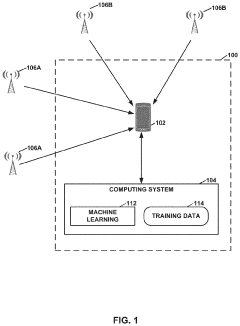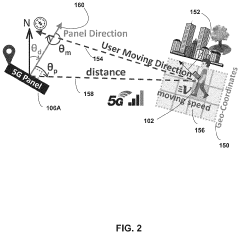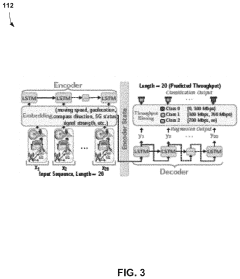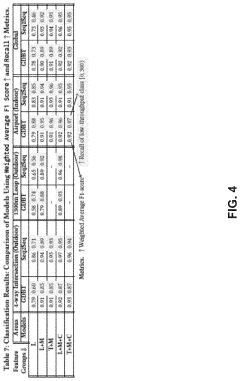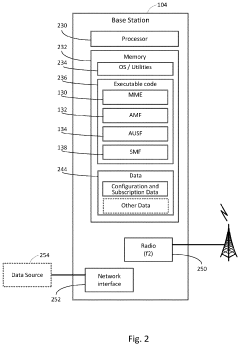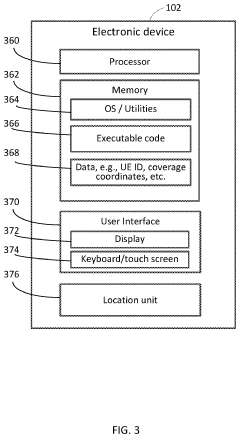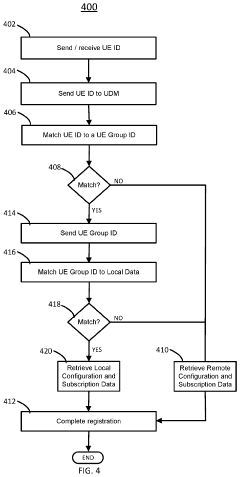What are the Benefits of 5G UC for Enhanced Customer Service Solutions?
JUL 18, 202510 MIN READ
Generate Your Research Report Instantly with AI Agent
Patsnap Eureka helps you evaluate technical feasibility & market potential.
5G UC Evolution and Goals
5G UC (Ultra-Capacity) represents a significant leap forward in mobile network technology, building upon the foundation laid by previous generations. This evolution aims to address the growing demands for faster, more reliable, and more versatile connectivity in customer service solutions. The primary goal of 5G UC is to enhance the capabilities of 5G networks by leveraging mid-band spectrum, which offers an optimal balance between coverage and capacity.
The evolution of 5G UC can be traced back to the initial deployment of 5G networks, which primarily focused on high-band mmWave spectrum for ultra-fast speeds in limited areas. As the technology progressed, the need for a more balanced approach became apparent, leading to the development of 5G UC. This mid-band implementation aims to provide widespread coverage while still delivering significant improvements in speed and capacity compared to 4G LTE networks.
One of the key objectives of 5G UC is to enable seamless and immersive customer service experiences. By offering higher bandwidth and lower latency, 5G UC facilitates the integration of advanced technologies such as augmented reality (AR) and virtual reality (VR) into customer support scenarios. This allows for more interactive and engaging customer interactions, potentially revolutionizing remote assistance and troubleshooting processes.
Another critical goal of 5G UC is to support the increasing demand for real-time data processing and analysis in customer service applications. With its enhanced capacity and reduced latency, 5G UC enables the rapid transmission and processing of large volumes of customer data. This capability is crucial for implementing advanced AI-driven customer service solutions, predictive analytics, and personalized customer experiences at scale.
The evolution of 5G UC also aims to address the growing need for reliable and high-quality video communication in customer service. As video-based customer support becomes more prevalent, 5G UC's improved bandwidth and stability ensure crystal-clear video calls, even in high-traffic areas or during peak usage times. This enhancement significantly improves the quality of video-based customer interactions, leading to more effective problem resolution and increased customer satisfaction.
Furthermore, 5G UC sets the stage for the widespread adoption of Internet of Things (IoT) devices in customer service scenarios. By providing the necessary network infrastructure to support a massive number of connected devices, 5G UC enables innovative customer service solutions that leverage IoT data for proactive support, predictive maintenance, and enhanced customer insights.
As 5G UC continues to evolve, its goals extend beyond mere technological improvements. The technology aims to drive digital transformation across various industries, with customer service at the forefront. By enabling more efficient, responsive, and personalized customer service solutions, 5G UC has the potential to redefine customer expectations and set new standards for service quality in the digital age.
The evolution of 5G UC can be traced back to the initial deployment of 5G networks, which primarily focused on high-band mmWave spectrum for ultra-fast speeds in limited areas. As the technology progressed, the need for a more balanced approach became apparent, leading to the development of 5G UC. This mid-band implementation aims to provide widespread coverage while still delivering significant improvements in speed and capacity compared to 4G LTE networks.
One of the key objectives of 5G UC is to enable seamless and immersive customer service experiences. By offering higher bandwidth and lower latency, 5G UC facilitates the integration of advanced technologies such as augmented reality (AR) and virtual reality (VR) into customer support scenarios. This allows for more interactive and engaging customer interactions, potentially revolutionizing remote assistance and troubleshooting processes.
Another critical goal of 5G UC is to support the increasing demand for real-time data processing and analysis in customer service applications. With its enhanced capacity and reduced latency, 5G UC enables the rapid transmission and processing of large volumes of customer data. This capability is crucial for implementing advanced AI-driven customer service solutions, predictive analytics, and personalized customer experiences at scale.
The evolution of 5G UC also aims to address the growing need for reliable and high-quality video communication in customer service. As video-based customer support becomes more prevalent, 5G UC's improved bandwidth and stability ensure crystal-clear video calls, even in high-traffic areas or during peak usage times. This enhancement significantly improves the quality of video-based customer interactions, leading to more effective problem resolution and increased customer satisfaction.
Furthermore, 5G UC sets the stage for the widespread adoption of Internet of Things (IoT) devices in customer service scenarios. By providing the necessary network infrastructure to support a massive number of connected devices, 5G UC enables innovative customer service solutions that leverage IoT data for proactive support, predictive maintenance, and enhanced customer insights.
As 5G UC continues to evolve, its goals extend beyond mere technological improvements. The technology aims to drive digital transformation across various industries, with customer service at the forefront. By enabling more efficient, responsive, and personalized customer service solutions, 5G UC has the potential to redefine customer expectations and set new standards for service quality in the digital age.
Customer Service Market Demand Analysis
The customer service market is experiencing a significant shift driven by the increasing demand for enhanced, personalized, and efficient service solutions. As businesses strive to improve customer satisfaction and loyalty, there is a growing need for advanced technologies that can revolutionize the customer service landscape. 5G UC (Ultra-Capacity) technology presents a compelling opportunity to address these market demands and transform the way businesses interact with their customers.
Market research indicates that the global customer experience management market is expected to grow substantially in the coming years, with a strong emphasis on digital transformation and omnichannel customer engagement. This growth is fueled by the rising expectations of consumers who demand seamless, real-time, and personalized interactions across various touchpoints. The advent of 5G UC technology aligns perfectly with these market trends, offering the potential to deliver ultra-fast, low-latency, and high-capacity connectivity that can support innovative customer service solutions.
One of the key drivers of market demand is the need for more efficient and responsive customer support systems. Businesses are seeking ways to reduce response times, improve first-call resolution rates, and provide more accurate and timely information to customers. 5G UC's capabilities in this regard are particularly relevant, as it can enable real-time data processing, instant access to customer information, and seamless integration of various communication channels.
Another significant market trend is the increasing adoption of artificial intelligence (AI) and machine learning (ML) in customer service applications. These technologies require robust network infrastructure to process vast amounts of data and deliver intelligent, context-aware responses. 5G UC's high-speed and low-latency characteristics can support the deployment of advanced AI-powered chatbots, virtual assistants, and predictive analytics tools, meeting the growing demand for more sophisticated and automated customer service solutions.
The market also shows a strong inclination towards immersive and interactive customer experiences. Augmented reality (AR) and virtual reality (VR) applications are gaining traction in customer service, particularly in industries such as retail, healthcare, and tourism. 5G UC's high bandwidth and low latency can facilitate the seamless integration of these technologies, enabling businesses to offer innovative and engaging customer service experiences that were previously not feasible.
Furthermore, there is a growing demand for mobile-first customer service solutions, as consumers increasingly prefer to interact with businesses through their smartphones and tablets. 5G UC's enhanced mobile broadband capabilities can support high-quality video calls, interactive mobile applications, and rich multimedia content delivery, catering to this market trend and enabling businesses to provide superior mobile customer service experiences.
In conclusion, the customer service market is ripe for innovation, with a clear demand for technologies that can deliver faster, more efficient, and more personalized service experiences. 5G UC technology presents a compelling solution to address these market needs, offering the potential to transform customer service operations and drive significant improvements in customer satisfaction and loyalty.
Market research indicates that the global customer experience management market is expected to grow substantially in the coming years, with a strong emphasis on digital transformation and omnichannel customer engagement. This growth is fueled by the rising expectations of consumers who demand seamless, real-time, and personalized interactions across various touchpoints. The advent of 5G UC technology aligns perfectly with these market trends, offering the potential to deliver ultra-fast, low-latency, and high-capacity connectivity that can support innovative customer service solutions.
One of the key drivers of market demand is the need for more efficient and responsive customer support systems. Businesses are seeking ways to reduce response times, improve first-call resolution rates, and provide more accurate and timely information to customers. 5G UC's capabilities in this regard are particularly relevant, as it can enable real-time data processing, instant access to customer information, and seamless integration of various communication channels.
Another significant market trend is the increasing adoption of artificial intelligence (AI) and machine learning (ML) in customer service applications. These technologies require robust network infrastructure to process vast amounts of data and deliver intelligent, context-aware responses. 5G UC's high-speed and low-latency characteristics can support the deployment of advanced AI-powered chatbots, virtual assistants, and predictive analytics tools, meeting the growing demand for more sophisticated and automated customer service solutions.
The market also shows a strong inclination towards immersive and interactive customer experiences. Augmented reality (AR) and virtual reality (VR) applications are gaining traction in customer service, particularly in industries such as retail, healthcare, and tourism. 5G UC's high bandwidth and low latency can facilitate the seamless integration of these technologies, enabling businesses to offer innovative and engaging customer service experiences that were previously not feasible.
Furthermore, there is a growing demand for mobile-first customer service solutions, as consumers increasingly prefer to interact with businesses through their smartphones and tablets. 5G UC's enhanced mobile broadband capabilities can support high-quality video calls, interactive mobile applications, and rich multimedia content delivery, catering to this market trend and enabling businesses to provide superior mobile customer service experiences.
In conclusion, the customer service market is ripe for innovation, with a clear demand for technologies that can deliver faster, more efficient, and more personalized service experiences. 5G UC technology presents a compelling solution to address these market needs, offering the potential to transform customer service operations and drive significant improvements in customer satisfaction and loyalty.
5G UC Technology Landscape
The 5G UC (Ultra-Capacity) technology landscape represents a significant leap forward in mobile network capabilities, offering enhanced performance and functionality for customer service solutions. This advanced network infrastructure combines the high-band millimeter wave (mmWave) spectrum with mid-band frequencies to deliver unprecedented speeds, ultra-low latency, and massive device connectivity.
At the core of 5G UC is the utilization of wider bandwidth channels, which enables faster data transmission rates and increased network capacity. This is achieved through the implementation of advanced antenna technologies such as Massive MIMO (Multiple-Input Multiple-Output) and beamforming, which optimize signal strength and coverage.
The 5G UC landscape also incorporates network slicing, a revolutionary feature that allows for the creation of multiple virtual networks tailored to specific use cases. This capability is particularly beneficial for customer service applications, as it enables dedicated network resources for mission-critical communications and high-bandwidth services.
Edge computing is another crucial component of the 5G UC ecosystem. By bringing computational resources closer to the end-user, edge computing significantly reduces latency and enhances real-time processing capabilities. This is especially valuable for customer service solutions that require instant data analysis and rapid response times.
The integration of artificial intelligence (AI) and machine learning (ML) algorithms within the 5G UC infrastructure further enhances network optimization and predictive maintenance. These technologies enable proactive network management, ensuring consistent service quality and minimizing downtime for customer-facing applications.
Security is a paramount concern in the 5G UC landscape. Advanced encryption protocols and network segmentation techniques are employed to protect sensitive customer data and prevent unauthorized access. This robust security framework is essential for maintaining customer trust and compliance with data protection regulations.
The 5G UC technology landscape also encompasses the development of new radio access network (RAN) architectures, such as Open RAN and virtualized RAN. These innovations promote vendor interoperability and network flexibility, allowing for more cost-effective and scalable deployments of customer service infrastructure.
As the 5G UC landscape continues to evolve, we are witnessing the emergence of new standards and protocols designed to further enhance network performance and reliability. These advancements pave the way for innovative customer service solutions that leverage augmented reality (AR), virtual reality (VR), and holographic communications, revolutionizing the way businesses interact with their customers.
At the core of 5G UC is the utilization of wider bandwidth channels, which enables faster data transmission rates and increased network capacity. This is achieved through the implementation of advanced antenna technologies such as Massive MIMO (Multiple-Input Multiple-Output) and beamforming, which optimize signal strength and coverage.
The 5G UC landscape also incorporates network slicing, a revolutionary feature that allows for the creation of multiple virtual networks tailored to specific use cases. This capability is particularly beneficial for customer service applications, as it enables dedicated network resources for mission-critical communications and high-bandwidth services.
Edge computing is another crucial component of the 5G UC ecosystem. By bringing computational resources closer to the end-user, edge computing significantly reduces latency and enhances real-time processing capabilities. This is especially valuable for customer service solutions that require instant data analysis and rapid response times.
The integration of artificial intelligence (AI) and machine learning (ML) algorithms within the 5G UC infrastructure further enhances network optimization and predictive maintenance. These technologies enable proactive network management, ensuring consistent service quality and minimizing downtime for customer-facing applications.
Security is a paramount concern in the 5G UC landscape. Advanced encryption protocols and network segmentation techniques are employed to protect sensitive customer data and prevent unauthorized access. This robust security framework is essential for maintaining customer trust and compliance with data protection regulations.
The 5G UC technology landscape also encompasses the development of new radio access network (RAN) architectures, such as Open RAN and virtualized RAN. These innovations promote vendor interoperability and network flexibility, allowing for more cost-effective and scalable deployments of customer service infrastructure.
As the 5G UC landscape continues to evolve, we are witnessing the emergence of new standards and protocols designed to further enhance network performance and reliability. These advancements pave the way for innovative customer service solutions that leverage augmented reality (AR), virtual reality (VR), and holographic communications, revolutionizing the way businesses interact with their customers.
Current 5G UC Implementation Strategies
01 AI-powered customer service solutions
Utilizing artificial intelligence and machine learning technologies to enhance customer service experiences in 5G UC environments. These solutions can include chatbots, virtual assistants, and automated response systems to handle customer inquiries efficiently and provide personalized support.- AI-powered customer service solutions: Utilizing artificial intelligence and machine learning technologies to enhance customer service in 5G UC environments. These solutions can include chatbots, virtual assistants, and automated response systems to handle customer inquiries efficiently and provide personalized support.
- Real-time network performance monitoring and optimization: Implementing systems for continuous monitoring of 5G UC network performance and customer experience. This includes tools for analyzing network data, identifying issues, and automatically optimizing network parameters to ensure high-quality service delivery.
- Self-service portals and mobile apps: Developing user-friendly self-service portals and mobile applications specifically designed for 5G UC customers. These platforms allow users to manage their accounts, troubleshoot common issues, and access support resources without the need for direct interaction with customer service representatives.
- Predictive maintenance and proactive support: Implementing predictive maintenance systems that use data analytics and machine learning to anticipate potential network issues or service disruptions. This allows for proactive support and maintenance, reducing downtime and improving overall customer satisfaction in 5G UC networks.
- Omnichannel customer engagement: Developing integrated omnichannel customer engagement platforms that provide seamless support across various communication channels. This ensures consistent customer experience and efficient issue resolution, regardless of whether customers interact through voice calls, chat, social media, or other channels in the 5G UC ecosystem.
02 Real-time data analytics for customer support
Implementing advanced analytics tools to process and analyze customer data in real-time, enabling faster decision-making and more effective problem-solving in 5G UC customer service scenarios. This approach allows for proactive issue identification and resolution.Expand Specific Solutions03 Omnichannel customer service integration
Developing integrated customer service platforms that seamlessly connect various communication channels, including voice, video, chat, and social media, to provide a consistent and unified experience across all touchpoints in the 5G UC ecosystem.Expand Specific Solutions04 Self-service and automated troubleshooting
Creating self-service portals and automated troubleshooting tools that leverage 5G UC capabilities to empower customers to resolve issues independently. This may include interactive guides, augmented reality assistance, and remote diagnostics.Expand Specific Solutions05 Predictive maintenance and network optimization
Implementing predictive maintenance systems and network optimization techniques to proactively address potential issues in the 5G UC infrastructure, minimizing service disruptions and improving overall customer satisfaction.Expand Specific Solutions
Key 5G UC Solution Providers
The 5G UC technology landscape is characterized by intense competition among major players in the telecommunications industry, with the market currently in a growth phase. Key companies like Samsung, Huawei, T-Mobile, Apple, and Nokia are driving innovation and deployment. The market size is expanding rapidly, with significant investments in infrastructure and device development. Technological maturity varies across different aspects of 5G UC, with some features well-established and others still evolving. Companies are focusing on enhancing network capabilities, improving customer experiences, and developing new applications to leverage the full potential of 5G UC for enhanced customer service solutions.
Samsung Electronics Co., Ltd.
Technical Solution: Samsung's 5G UC approach to enhancing customer service solutions leverages its end-to-end 5G network capabilities and device ecosystem. The company has developed a comprehensive platform that integrates 5G-enabled smartphones, wearables, and IoT devices to create a seamless customer experience[13]. Samsung's solution includes advanced beamforming and massive MIMO technologies to ensure reliable connectivity in high-density areas, such as retail stores or customer service centers[14]. The company has also implemented a 5G-powered digital twin technology for product visualization and remote troubleshooting, allowing customers to interact with virtual representations of products and receive real-time assistance[15].
Strengths: Strong integration between network infrastructure and consumer devices, extensive 5G patent portfolio, and global brand recognition. Weaknesses: Relatively newer entrant in the network infrastructure market compared to some competitors, and potential for conflicts of interest with some telecom operators due to its consumer device business.
Huawei Technologies Co., Ltd.
Technical Solution: Huawei's 5G UC solution for enhanced customer service focuses on creating a seamless omnichannel experience. Their platform integrates edge computing with 5G to enable real-time data processing and analysis at the network edge[4]. This allows for personalized customer interactions and predictive service recommendations. Huawei's solution also incorporates advanced biometric authentication methods, such as facial recognition and voice analysis, to enhance security and streamline customer identification processes[5]. The company has developed a 5G-powered augmented reality (AR) remote assistance system, enabling technicians to provide visual guidance to customers or field agents in real-time, significantly reducing resolution times for complex issues[6].
Strengths: Strong R&D capabilities, comprehensive end-to-end 5G solutions, and advanced AI integration. Weaknesses: Geopolitical challenges affecting global market access, and potential security concerns in some markets.
Core 5G UC Innovations for Customer Service
Using user-side contextual factors to predict cellular radio throughput
PatentPendingUS20230068437A1
Innovation
- A machine learning framework is developed to predict 5G throughput by identifying key user equipment (UE) side factors and constructing a performance model using a wide variety of features, allowing for context-aware predictions and adaptive augmentation with 4G networks to ensure reliable edge offloading.
Access and mobility function (AMF) data storage in cellular network registration
PatentActiveUS20220272521A1
Innovation
- Storing configuration and subscription data locally within the Access and Mobility Function (AMF) and using a UE ID to initiate registration, allowing the AMF to retrieve the necessary data locally instead of from a remote UDM, thereby reducing latency and bandwidth usage.
5G UC Security and Privacy Considerations
As 5G UC (Ultra-Capacity) technology continues to revolutionize customer service solutions, it is crucial to address the security and privacy considerations associated with its implementation. The high-speed, low-latency nature of 5G UC networks introduces new vulnerabilities that must be carefully managed to protect sensitive customer data and maintain the integrity of service operations.
One of the primary security concerns in 5G UC networks is the increased attack surface due to the proliferation of connected devices and edge computing nodes. This expanded network infrastructure creates more potential entry points for malicious actors, necessitating robust security measures across the entire ecosystem. Organizations must implement comprehensive endpoint security solutions and regularly update firmware and software to mitigate risks associated with device vulnerabilities.
Data privacy is another critical consideration in 5G UC-enabled customer service solutions. The enhanced capabilities of 5G networks allow for the collection and processing of vast amounts of customer data in real-time. While this enables more personalized and efficient service delivery, it also raises concerns about data protection and compliance with privacy regulations such as GDPR and CCPA. Companies must implement strong data encryption protocols, both in transit and at rest, to safeguard customer information from unauthorized access or breaches.
Network slicing, a key feature of 5G UC technology, presents both opportunities and challenges for security and privacy. While it allows for the creation of isolated, virtual network segments tailored to specific service requirements, it also introduces the need for sophisticated access control and authentication mechanisms. Organizations must carefully manage network slice configurations and implement zero-trust security models to ensure that only authorized users and devices can access sensitive customer service resources.
The use of artificial intelligence and machine learning in 5G UC-powered customer service solutions also raises privacy concerns. These technologies often rely on large datasets to improve service quality and personalization. However, the collection and analysis of such data must be conducted in a transparent and ethical manner, with clear consent mechanisms in place for customers. Companies should implement privacy-preserving AI techniques, such as federated learning, to minimize the exposure of individual customer data while still benefiting from collective insights.
As 5G UC networks become more prevalent in customer service operations, organizations must also consider the implications of cross-border data flows and data sovereignty requirements. The global nature of 5G technology may necessitate the transfer of customer data across international boundaries, potentially conflicting with local data protection laws. Companies must carefully navigate these regulatory landscapes and implement appropriate data localization strategies where necessary to ensure compliance and maintain customer trust.
In conclusion, while 5G UC technology offers significant benefits for enhanced customer service solutions, it is imperative that organizations prioritize security and privacy considerations in their implementation strategies. By addressing these challenges proactively, companies can harness the full potential of 5G UC while maintaining the trust and confidence of their customers in an increasingly connected world.
One of the primary security concerns in 5G UC networks is the increased attack surface due to the proliferation of connected devices and edge computing nodes. This expanded network infrastructure creates more potential entry points for malicious actors, necessitating robust security measures across the entire ecosystem. Organizations must implement comprehensive endpoint security solutions and regularly update firmware and software to mitigate risks associated with device vulnerabilities.
Data privacy is another critical consideration in 5G UC-enabled customer service solutions. The enhanced capabilities of 5G networks allow for the collection and processing of vast amounts of customer data in real-time. While this enables more personalized and efficient service delivery, it also raises concerns about data protection and compliance with privacy regulations such as GDPR and CCPA. Companies must implement strong data encryption protocols, both in transit and at rest, to safeguard customer information from unauthorized access or breaches.
Network slicing, a key feature of 5G UC technology, presents both opportunities and challenges for security and privacy. While it allows for the creation of isolated, virtual network segments tailored to specific service requirements, it also introduces the need for sophisticated access control and authentication mechanisms. Organizations must carefully manage network slice configurations and implement zero-trust security models to ensure that only authorized users and devices can access sensitive customer service resources.
The use of artificial intelligence and machine learning in 5G UC-powered customer service solutions also raises privacy concerns. These technologies often rely on large datasets to improve service quality and personalization. However, the collection and analysis of such data must be conducted in a transparent and ethical manner, with clear consent mechanisms in place for customers. Companies should implement privacy-preserving AI techniques, such as federated learning, to minimize the exposure of individual customer data while still benefiting from collective insights.
As 5G UC networks become more prevalent in customer service operations, organizations must also consider the implications of cross-border data flows and data sovereignty requirements. The global nature of 5G technology may necessitate the transfer of customer data across international boundaries, potentially conflicting with local data protection laws. Companies must carefully navigate these regulatory landscapes and implement appropriate data localization strategies where necessary to ensure compliance and maintain customer trust.
In conclusion, while 5G UC technology offers significant benefits for enhanced customer service solutions, it is imperative that organizations prioritize security and privacy considerations in their implementation strategies. By addressing these challenges proactively, companies can harness the full potential of 5G UC while maintaining the trust and confidence of their customers in an increasingly connected world.
ROI Analysis for 5G UC in Customer Service
The implementation of 5G UC (Ultra-Capacity) in customer service solutions offers significant potential for return on investment (ROI). This analysis examines the financial benefits and cost considerations associated with adopting 5G UC technology in customer service operations.
One of the primary drivers of ROI is the increased efficiency in customer interactions. 5G UC enables faster data transmission and lower latency, allowing customer service representatives to access and process information more quickly. This reduction in wait times and improved responsiveness can lead to higher customer satisfaction rates and increased loyalty, ultimately contributing to improved customer retention and lifetime value.
The enhanced bandwidth of 5G UC also supports more sophisticated customer service tools, such as high-quality video conferencing and augmented reality (AR) applications. These technologies can significantly improve the quality of remote support, reducing the need for on-site visits and decreasing overall service costs. The ability to diagnose and resolve issues remotely not only saves time but also reduces travel expenses and increases the number of customers that can be served per day.
From a cost perspective, the initial investment in 5G UC infrastructure and compatible devices may be substantial. However, the long-term savings in operational costs can offset this initial outlay. For instance, the improved network capacity allows for more efficient use of cloud-based services, potentially reducing the need for on-premises hardware and associated maintenance costs.
The scalability of 5G UC networks also provides a favorable ROI outlook. As customer service demands grow, the network can accommodate increased data traffic without significant additional infrastructure investments. This scalability ensures that the initial investment continues to deliver value as the business expands.
Moreover, 5G UC enables more effective data analytics and artificial intelligence applications in customer service. The ability to process and analyze large volumes of customer data in real-time can lead to more personalized service, predictive maintenance, and proactive issue resolution. These capabilities not only improve customer satisfaction but also optimize resource allocation and reduce overall service costs.
In conclusion, while the initial investment in 5G UC technology for customer service may be significant, the potential for long-term cost savings, improved efficiency, and enhanced customer satisfaction presents a compelling case for positive ROI. Organizations should carefully consider their specific use cases and conduct thorough cost-benefit analyses to determine the optimal implementation strategy for their customer service operations.
One of the primary drivers of ROI is the increased efficiency in customer interactions. 5G UC enables faster data transmission and lower latency, allowing customer service representatives to access and process information more quickly. This reduction in wait times and improved responsiveness can lead to higher customer satisfaction rates and increased loyalty, ultimately contributing to improved customer retention and lifetime value.
The enhanced bandwidth of 5G UC also supports more sophisticated customer service tools, such as high-quality video conferencing and augmented reality (AR) applications. These technologies can significantly improve the quality of remote support, reducing the need for on-site visits and decreasing overall service costs. The ability to diagnose and resolve issues remotely not only saves time but also reduces travel expenses and increases the number of customers that can be served per day.
From a cost perspective, the initial investment in 5G UC infrastructure and compatible devices may be substantial. However, the long-term savings in operational costs can offset this initial outlay. For instance, the improved network capacity allows for more efficient use of cloud-based services, potentially reducing the need for on-premises hardware and associated maintenance costs.
The scalability of 5G UC networks also provides a favorable ROI outlook. As customer service demands grow, the network can accommodate increased data traffic without significant additional infrastructure investments. This scalability ensures that the initial investment continues to deliver value as the business expands.
Moreover, 5G UC enables more effective data analytics and artificial intelligence applications in customer service. The ability to process and analyze large volumes of customer data in real-time can lead to more personalized service, predictive maintenance, and proactive issue resolution. These capabilities not only improve customer satisfaction but also optimize resource allocation and reduce overall service costs.
In conclusion, while the initial investment in 5G UC technology for customer service may be significant, the potential for long-term cost savings, improved efficiency, and enhanced customer satisfaction presents a compelling case for positive ROI. Organizations should carefully consider their specific use cases and conduct thorough cost-benefit analyses to determine the optimal implementation strategy for their customer service operations.
Unlock deeper insights with Patsnap Eureka Quick Research — get a full tech report to explore trends and direct your research. Try now!
Generate Your Research Report Instantly with AI Agent
Supercharge your innovation with Patsnap Eureka AI Agent Platform!
